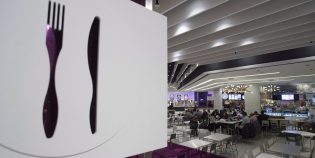“Hi. I’m Bonnie Brooks,” says the raspy-voiced president and chief executive officer of the Bay in
one of dozens of radio ads that have been running over the past year. These four simple words have become a mnemonic of cool for throngs of fashion-forward females, and a way of introducing the latest styles, labels and trends offered by the HBC-owned department store.
Brooks has promoted everything from high-end cosmetics and pashmina shawls to the latest items from Jessica Simpson’s clothing line. Not long ago, the Bay was competing with other mall-based fashion retailers and was seen more as a destination for towels and toasters than fashion.
With 30 years of retail experience, Brooks got her start at Canadian fashion chain Fairweather, worked briefly as editor-in-chief of Flare magazine and was president of department store Lane Crawford in Hong Kong. And in her two years in charge of the Bay, she is credited with breathing new life into the once-tired chain, regaining the credibility lost to niche stores and boutiques. “She has come in and I think changed the look and feel of the Bay dramatically,” says Ron Telpner, chair and CEO of Toronto-based advertising agency The BrainStorm Group. “[Brooks] has a proven track record in turning large retail stores around, so certainly that’s the most powerful weapon they have in their arsenal right now,” says Derick Chetty, fashion columnist for the Toronto Star.
Even with the number of popular U.S. retailers like Victoria’s Secret opening in Canada, the big story in retail this year was the Bay, he says. “They’re really working on getting rid of that stodgy image and making it a very cool destination, a place where you can actually find unique items.” The Bay’s roots run nearly 350 years deep, and yet the retailer looked decidedly fresh, playful and full of life this year. Brooks made a strong statement about her direction when she committed $5 million last fall to re-open The Room—a high-end boutique housed within its flagship Queen St. location in the heart of downtown Toronto–that is now double its original size and carries close to 70 luxury lines including some haute couture. The Room is a modern reinvention of the St. Regis Room, which first opened in the 1930s (when the store was still a Simpsons) and was considered a fashion haven for Toronto ladies who lunched. With its stark white walls, the space, decorated by hot Toronto design firm Yabu Pushelberg, now acts as a brilliantly merchandized gallery with sleek mannequins showcasing luxury brands including legendary fashion
house Halston, Proenza Schouler and Canadianborn designer Erdem Morglioglu.
“The Room really served notice that we were back in the fashion business,” says Patrick Dickinson, the Bay’s vice-president, marketing. Yet, the decision to reinvent The Room was met with some trepidation from the ownership group, he adds. While most retailers were still trying to recapture the sales magic of pre-recessionary times, Brooks was suggesting the Bay go upmarket and focus on the fashion elite. She was adamant and convinced the board it would be money well spent.
And she was right. While Dickinson won’t share specifics, he did say sales at the flagship location are 22% higher compared to last year. “If you think about that in terms of the volume that this store does, [it’s] all a carryover effect of The Room, of the kind of customers and clientele The Room brings into the store, of the kind of caché it’s lent to the entire store,” he says. Thrilled with the success so far, the Bay plans to take The Room concept to its downtown Vancouver and Montreal locations next year.
Of course, Brooks wasn’t making the changes without some numbers and research to back her. She hired Bain and Company, a U.S.-based consulting firm in 2008. The firm interviewed 7,000 Canadian shoppers and found there was a need for a fashion-focused department store in the midto- high range.
“People want to shop at a destination and brands are important to people interested in fashion because there is a difference in the cut of a jacket or the pattern of a skirt,” says Dickinson. Brooks gave the Bay a fashion facelift, dropping 800 underperforming brands (including Liz Claiborne and Bill Blass) and added 250 new fashion labels, such as Juicy Couture and Hugo Boss. “The Bay was not seen as the fashion place. It was Bay Day and a lot of tired brands so she’s eliminated a ton of brands,” says Telpner. “They really had no meaning and had no backing and brought in brands that demonstrate they’re walking the talk.” Months later, the Bay followed up with the opening of The White Space, a contemporary designer section featuring young and hip pieces priced with the everyday purchaser in mind.
“The White Space is more contemporary so it’s a younger look, it’s a younger feel and it’s more affordable so it’s really for any kind of fashionthinking woman,” says Dickinson. While The White Space sections can only be found at four locations across the country, more
than 20 stores carry the same labels sold by the department. “We’re gradually pushing that fashionable perspective and the interesting thing is wherever we go, the sales are there,” says Dickinson. “Wherever you get rid of the clutter and you put in the right merchandise, there is absolutely a demand for it and we haven’t really run into any stumbles.” The Bay has received praise from the media, especially fashion blogs, for making such moves.
In August, The Room even made it to a New York Times list of Toronto’s style hot spots for “Giving Holts a run for its money,” and has become a shopping destination for celebrities like Hillary Duff. “This spot is wall-to-wall fancy frocks, stand-out shoes and all sorts in between (in an airy, stunning space),” exclaimed women’s lifestyle website SweetSpot.ca. “We were wowed by the range of designers… Even if it’s just to check out some eye candy, this is a room worth seeing.” And while the Bay made great strides over the last year to offer consumers modern (and exclusive) products, it also showed it understood and could leverage its historic status as vaunted symbol of Canadiana. The retailer collaborated with big-name designers to create versions of its iconic Hudson’s Bay blanket, putting its blue, red, green and yellow stripes on Peterborough canoes and most recently on Burton snowboards.
Shoppers can also expect a specially designed shoe from K-Swiss and sweaters from Pink Tartan, says Dickinson. One of the more poignant moments was the launch of a $10-million-plus campaign to promote its Olympic clothing line with a TV spot that highlighted HBC’s centuries-old Canadian roots with the declaration “We were made for this.” Of course all things Canadian were popular during the Vancouver Games, but the Bay brilliantly rode the wave of Canadian pride that swept across the country.
“The Olympics, because of the hyper patriotism associated with it was a great opportunity for us to—in a really fun way—reconnect with our own history, which is everybody’s history,” says Dickinson. But like everything the Bay does these days, the focus was still on fashion. At the time, HBC CEO Jeff Sherman (who retired in June) said the goal was to create Olympic wear that could be part of customers’ permanent wardrobes, rather than just a temporary souvenir. The retailer designed a collection on the foundation of iconic Canadian items like parkas, buffalo plaid, and traditional sweaters hand-made by B.C. aboriginal knitters.
“It’s very wearable stuff and our learning was people don’t necessarily want athletic apparel, they don’t want fashion. It’s [about] patriotism,” says Dickinson. “They want to identify with the team at the Games. I think the fashion is exactly where it needs to be. It’s not too contemporary hard-to-wear stuff, but it’s beautiful.”
Perhaps the most talked-about piece was a pair of red wool mittens with a white maple leaf on the palm that sold for only $10 a pair. U.S. talk show host Oprah pronounced them the “hottest item” at the Olympics . To date, HBC has sold more than 3.5 million pairs.
“As a retailer, they owned the Olympics and when they came out with that commercial it really captured the history and a feel for the Bay and what they’ve done with their brands and having the heritage at the Bay featured,” says Telpner. The heritage-inspired ad is one of the last major television campaigns launched by the company over the past year, aside from a 30-second execution that honed in on the urbane, fashion-savvy shopper using photography stills from the retailer’s online fashion site Look Book and fl yers. “We’re trying to spell out that we’re cool, fi nally, or again, and that we have really great brands that can compete with the really high-level department stores,” Tony Smith, creative director at the Bay, told Marketing when the campaign was launched.
Smith, a former art director at Fashion who joined the Bay nine months ago, says the retailer has been using top Canadian and American photographers to ready its ads for more premium publications. (While John St. had been the Bay’s agency of record since early 2007, Smith says the retailer doesn’t currently have an AOR and is instead working with a host of agencies on various projects as they come up.) The sophisticated and clean concept lends itself nicely to full-page newspaper ads the Bay runs in The Globe and Mail and the Toronto Star. Instead of chopping the ad into little boxes to highlight sales and promotions throughout the store, the Bay now focuses on one item at a time. “Even if we’re selling all the dresses in a department, we show the most beautiful dress to make a statement,” says Dickinson. But he points to those radio spots starring Brooks—he calls her the Bay’s “chief news person”—as a vital and effective channel in its communications strategy .
“She is reading the news to people and absolutely there are a legion of people out there who hear those things and respond,” he says. “We know that from sales. So when she talks about a certain item, or a certain brand, or a certain program, it starts to move… We’re gradually having an effect and bringing people back in.”









